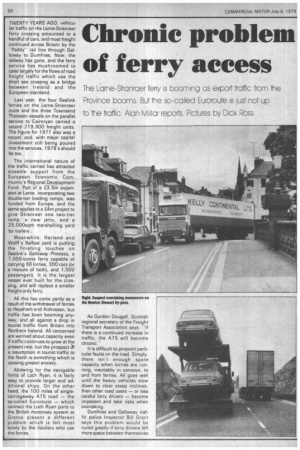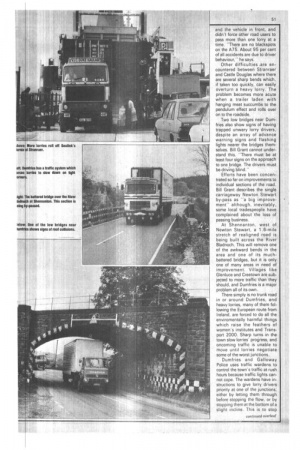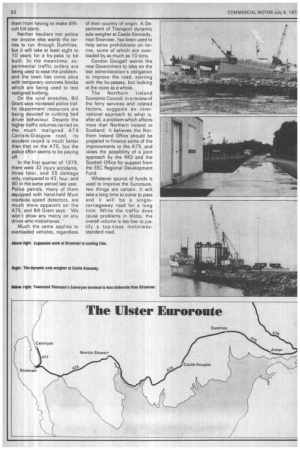Chronic problem of ferry access
Page 52

Page 53

Page 54

If you've noticed an error in this article please click here to report it so we can fix it.
The Larne-Stranraer ferry is booming as export traffic from the Province booms. But the so-called Euroroute is just not up to the traffic. Alan V illar reports. Pictures by Dick Ross,
TWENTY YEARS AGO, vehicular traffic on the Larne-Stranraer ferry crossing amounted to a handful of cars, and most freight continued across Britain by the "Paddyrail line through Galloway to Dumfries. Now, the railway has gone, and the ferry service has mushroomed to cater largely for the flows of road freight traffic which use the short sea crossing as a bridge between Ireland and the European mainland.
Last year, the four Sealink ferries on the Larne-Stranraer route and the three Townsend Thoresen vessels on the parallel service to Cairnryan carried a record 219,900 freight units. The figure for 1977 also was a record, and, with major capital investment still being poured into the services, 1979's should be too.
The international nature of the traffic carried has attracted sizeable support from the European Economic Community's Regional Development Fund. Part of a £3.5m expansion at Larne, incorporating two double-tier loading ramps, was funded from Europe, and the same applies to a E.4m project to give Stranraer one two-tier ramp, a new jetty, and a 25,000sgm marshalling yard for trailers..
Meanwhile, Harland and Wolff's Belfast yard is putting the finishing touches on Sealink's Galloway Princess, a 7,000-tonne ferry capable of carrying 60 lorries, 300 cars (or a mixture of both), and 1,000 passengers. It is the largest vessel ever built for the crossing, and will replace a smaller freight-only ferry.
All this has come partly as a result of the withdrawal of ferries to Heysham and Ardrossan, but traffic has been booming anyway, and all against a drop in tourist traffic from Britain into Northern Ireland. All concerned are worried about capacity even if traffic continues to grow at the present rate, but the prospect rf a resumption in tourist traffic to the North is something which is causing greater anxiety.
Allowing for the navigable limits of Loch Ryan, it is fairly easy to provide larger and additional ships. On the other hand, the 100 miles of singlecarriageway A75 road — the so-called Euroroute — which connect the Loch Ryan ports to the British motorway system at Gretna present a different problem which is felt most sorely by the hauliers who use the ferries. As Gordon Dougall, Scottish regional secretary of the Freight Transport Association says: "If there is a continued increase in traffic, the A75 will become chronic."
It is difficult to pinpoint particular faults on the road. Simply, there isn't enough spare capacity when lorries are running, inevitably in convoys, to and from ferries. All goes well until the heavy vehicles slow down to clear steep inclines, then other road users — or less careful lorry drivers — become impatient and take risks when overtaking.
Dumfries and Galloway traffic police Inspector Bill Grant says this problem would be cured greatly if lorry drivers left more space between themselves and the vehicle in front, and didn't force other road users to pass more than one lorry at a time. "'There are no blackspots on the A75. About 95 per cent of all accidents are due to driver behaviour,'" he says.
Other difficulties .are encountered between Stranraer and Castle Douglas where there are several sharp bends which, if taken too quickly, can easily overturn a heavy lorry. The problem becomes more acute when a trailer laden with hanging meat succumbs to the pendulum effect and rolls over on to the roadside.
Two low bridges near Dumfries also show signs of having trapped unwary lorry drivers, despite an array of advance warning signs and flashing lights nearer the bridges themselves. Bill Grant cannot understand this. "There must be at least four signs on the approach to one bridge. The drivers must be driving blind."
Efforts have been concentrated so far on improvements to individual sections of the road. Bill Grant describes the single carriageway Newton Stewart by-pass as "a big improvement"' although, inevitably, some local tradespeople have complained about the loss of passing business.
At Shennanton, west of Newton Stewart, a 1.6-mile stretch of realigned road is being built across the River Bladnoch. This will remove one of the awkward bends in the area and one of its muchbattered bridges, but it is only one of many areas in need of improvement. Villages like Glenluce and Creetown are subjected to more traffic than they should, and Dumfries is a major problem all of its own.
There simply is no trunk road in or around Dumfries, and heavy lorries, many of them following the European route from Ireland, are forced to do all the enviromentally harmful things which raise the feathers of women's institutes and Transport 2000. Sharp turns in the town slow lorries' progress, and oncoming traffic is unable to move until lorries negotiate some of the worst junctions.
Dumfries and Galloway Police uses traffic wardens to control the town's traffic at rush hours because traffic lights cannot cope. The wardens have instructions to give lorry drivers priority at one of the junctions; either by letting them through before stopping the flow, or by stopping them at the bottom of a slight incline. This is to stop them from having to make difficult hill starts.
Neither hauliers nor police nor anyone else wants the lorries to run through Dumfries, but it will take at least eight to 10 years for a by-pass to be built. In the meantime, ex perimental traffic orders are being used to ease the problem, and the town has come alive with temporary concrete blocks which are being used to test realigned kerbing.
On the rural stretches, Bill Grant says increased police traf fic department resources are being devoted to curbing bad driver behaviour. Despite the higher traffic volumes carried on the much maligned A74 Carlisle-Glasgow road, its accident record is much better than that on the A75, but the police effort seems to be paying off.
In the first quarter of 1979, there were 32 injury accidents, three fatal, and 55 damage only, compared to 43, four, and 60 in the same period last year.
Police patrols, many of them equipped with hand-held Muni roadside speed detectors, are much more apparent on the A75, and Bill Grant says: "We won't show any mercy on any driver who misbehaves."
Much the same applies to overloaded vehicles, regardless of their country of origin. A Department of Transport dynamic axle weigher at Castle Kennedy, near Stranraer, has been used to help serve prohibitions on lorries, some of which are overloaded by as much as 10 tons.
Gordon Dougall wants the new Government to take on the last administration's obligation to improve the road, starting with the by-passes, but looking at the route as a whole.
The Northern Ireland Economic Council, in a review of the ferry services and related factors, suggests an international approach to what is, after all, a problem which affects more than Northern Ireland or Scotland. It believes the Nor thern Ireland Office should be prepared to finance some of the improvements to the A75, and raises the possibility of a joint approach by the NIO and the Scottish Office for support from the EEC Regional Development Fund.
Whatever source of funds is used to improve the Euroroute, two things are certain. It will take a long time to come to pass and it will be a single carriageway road for a long time. While the traffic does cause problems in blobs, the overall volume is too low to justify a top-class motorwaystandard road.




























































































































